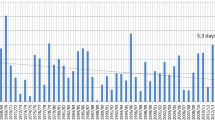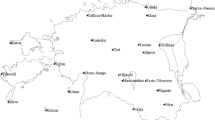Abstract
The presence of snow along a portion of the Croatian highlands has enabled the development of winter tourism that is primarily oriented toward snow-related activities. Snow is more abundant and stays on the ground longer in the mountainous district of Gorski kotar (south eastern edge of the Alps) and on Mount Velebit (Dinaric Alps), which have elevations of up to 1,600 m and are close to the Adriatic coast than over the inland hilly region of north western Croatia where the summits are not more than approximately 1,000 m high. Basic information about the snow conditions at these locations was gathered for this study, including the annual cycle and probabilities for various snow parameters at different altitudes. As requested by the Croatian Ski Association, the relation between the air temperature and the relative humidity was investigated to determine the feasibility of artificial snowmaking. The snow parameters are highly correlated to air temperature, surface air pressure and precipitation, with certain differences occurring as a result of the altitude. Since the beginning of the second half of the twentieth century, winter warming and a significant increase in the mean air pressure (more anticyclonic situations) have been detected at all sites. Winter precipitation totals decreased at medium altitudes and increased at the summit of Mount Velebit, but these trends were not significant. The frequency of precipitation days and of snowfall decreased whereas an increasing fraction of the precipitation days at high altitudes involved solid precipitation. In contrast, a decreasing fraction of the precipitation days at medium altitudes involved solid precipitation, probably because of the different warming intensities at different altitudes. The mean daily snow depth and the duration of snow cover both slightly decreased at medium altitudes whereas the snow cover duration slightly increased at the mountainous summit of Mount Velebit.








Similar content being viewed by others
References
Abegg B (1996) Klimaänderung und Tourismus. Vdf Hochschulverlag.
Branković Č, Bray J, Callaway J, Dulčić J, Gajić-Čapka M, Glamuzina B, Heim I, Japec L, Kalinski V, Landau S, Legro S, OIKON OF, Patarčić M, Srnec L, Šimleša D, Zaninović K, Znaor D (2009) A climate for change—climate change and its impacts on society and economy in Croatia. Human Development Report–Croatia 2008. United Nations Development programme (UNDP) in Croatia, Zagreb, p 281
Beniston M (1997) Variations of snow depth and duration in the Swiss Alps over the last 50 years: links to changes in large-scale climatic forcing. Clim Change 36:281–300
Beniston M (2003) Climate change in mountainous regions: a review of possible impacts. Clim Change 59:5–31
Beniston M, Keller F, Goyette S (2003) Snow pack in the Swiss Alps under changing climatic conditions: an empirical approach for climatic impacts studies. Theor Appl Climatol 74:19–31
Beniston M, Rebetez M, Giorgi F, Marinucci MR (1994) An analysis of regional climate change in Switzerland. Theor Appl Climatol 49:135–159
Böhm R, Auer I, Brunetti M, Maugeri M, Nanni T, Schoner W (2001) Regional air temperature variability in the European Alps: 1760–1998 from homogenized instrumental time series. Int J Climatol 21:1779–1801
Breiling M, Charamza P (1994) Localising the threats due to global climate change in mountain environment. Proceedings of ProClim Conference, Davos. In: Beniston M (ed) Mountain environments in changing climates, vol 16. Routledge, London
Breiling M, Charamza P (1999) The impact of global warming on winter tourism and skiing: a regionalised model for Austrian snow conditions. Reg Environ Change 1:4–14
Breiling M, Charamza P, Skage O R (1999) Klimasenssibilität Österreichischer Bezirke mit besonderer Berücksichtigung des Wintertourismus. Report 97:1, Institute for Landscape Planning (Alnarp Austria)
Buerki R, Elsasser H, Abegg B. (2003) Climate change—impacts on the tourism industry in mountain areas. First Int. Conference on Climate Change and Tourism, Djebra, 9–11 April 2003
Cegnar T (1996) Relations among significant temperature, pracipitation and snow cover anomalies. Proceedings of the 24th International Conference on Alpine Meteorology, ICAM 96, 1996 September 9–13; Bled, Slovenia, 230–236
Elsasser H, Buerki R (2002) Climate change as a threat to tourism in the Alps. Clim Res 20:253–257
Endler Ch, Oehler K, Matzarakis A (2010) Vertical gradient of climate change and climate tourism conditions in the Black Forest. Int J Biometeorol 54:45–61. doi:10.1007/s00484-009-0251-2
Gajić-Čapka M (2007) Snow baseline conditions and changes for the winter tourism. In: Matzarakis A, de Freitas CR, Scott D (eds) Developments in tourism climatology. Commission on Climate Tourism and Recreation, International Society of Biometeorology, Freiburg, ISBN: 978-3-00-024110-9, www.mif.uni-freiburg.de/isb
Gajić-Čapka M, Horak S (2007) Changes in snow parameters in Croatian highland. In: Amelung B, Blazejczyk K, Matzarakis A (eds) Climate change and tourism: assessment and coping strategies. Maastricht-Warsaw-Freiburg, ISBN: 978-00-023716-4 (www.mif.uni-freiburg.de/matzarakis/cct_nato.htm), pp 105–115
Gajić-Čapka M, Srnec L (2008) Response of snow parameters relevant for winter tourism to climate change. 18th International Congress of Biometeorology, Harmony with Nature, Iriki Masami (ed.), 22–26 September 2008, Tokyo, Japan, CD, Poster session, Tourism, Tour-P02
Gajić-Čapka M, Zaninović K (1997) Changes in temperature extremes and their possible causes at the SE boundary of the Alps. Theor Appl Climatol 57(1–2):89–94
Hantel M, Ehrendorfer M, Haslinger A (2000) Climate sensitivity of snow cover duration in Austria. Int J Climatol 20:615–640
Hofstätter M, Formayer H (2007) Sub-daily model to investigate the time available for artificial snow making. 29th International Conference on Alpine Meteorology, Chambéry, France, 4–8 June 2007, Abstract 3K.14
Hofstätter M, Formayer H, Haas P (2009) Snow reliability in ski resorts considering artificial snowmaking. Geophysical Research Abstracts, vol. 11, EGU2009-9678-1
IPCC (2007) Climate change 2007: impacts, adaptation and vulnerability. In: Parry ML, Canziani OF, Palutikof JP, van der Linden PJ, Hanson CE (eds), Cambridge University Press, Cambridge. Contribution of Working Group II to the Fourth Assessment Report of the Intergovernmental Panel on Climate Change.
Kirigin B (1963) Climate conditions of the Medvednica Mountain (in Croatian). Hydrometeorological Institute of SR Croatia. Rasprave i prikazi 9:1–72
Kirigin B (1970) Klimatske karakteristike i snježne prilike u planinskim krajevima Hrvatske (Climate characteristics and snow conditions in mountainous areas of Croatia). In: Mogućnosti razvoja zimskog turizma u SR Hrvatskoj (Possibilities of winter tourism development in SR Croatia), Opatija, Croatia, pp 19–62
Kirigin B (1976) Klimatske i snježne prilike na području Bjelolasice i Gorskog kotara (Climate characteristics and snow conditions on Mount Bjelolasica and in the mountainous district of Gorski kotar). Radni izvještaji Republičkog hidrometeorološkog zavoda SR Hrvatske, 7, pp 25
Laternser M, Schneebeli M (2003) Long-term snow climate trends of the Swiss Alps (1931–99). Int J Climatol 23:733–750
Matzarakis A (2006) Weather- and climate-related information for tourism. Tourism Hospit Plann Dev 3:99–115
Mitchel JM Jr, Dzerdzeevskii B, Flohn H et al (1966) Climatic change. WMO tech. note no. 79. World Meteorological Organization, Geneva, pp 79
Navarre J-P, Giraud G, Goetz D, Durand Y (2007) Climatic trends for the last 45 winters in a French Alps region. 29th International Conference on Alpine Meteorology, Chambéry, France, 4–8 June 2007, pp 179–182
OECD (2007) Climate change in the European Alps. Adapting winter tourism and natural hazards management. Organisation for Economic Co-Operation and Development, Paris Cedex 16
Rebetez M (1996) Seasonal relationship between temperature, precipitation and snow cover in a mountainous region. Theor Appl Climatol 54:99–106
Sauter T, Weitzenkamp B, Schneider C (2009) Spatio-temporal prediction of snow cover in the Black Forest mountain range using remote sensing and a recurrent neural network. Int J Climatol. doi:10.1002/joc.2043
Scherrer SC, Appenzeller Ch (2006) Swiss Alpine snow pack variability: major patterns and links to local climate and large-scale flow. Clim Res 32:187–199
Schneider C, Sauter T, Weitzenkamp B (2009) Klimawandel und wintersport in Mittelgebirgen. In: Nationalatlas aktuell 11 (11/2009). Leipzig: Leibniz-Institut für Länderkunde (IfL)
Scott D, McBoyle G, Mills B (2003) Climate change and the skiing industry in southern Ontario (Canada): exploring the importance of snowmaking as a technical adaptation. Clim Res 23:171–181
Scott D (2005) Ski industry adaptation to climate change: hard, soft and policy strategies. In: Gossling S, Hall M (eds) Tourism and global environmental change. Routledge, Oxford, pp 265–285
Sneyers R (1990) On the statistical analysis of series of observations. WMO tech. note no. 143. WMO, Geneva
Valt M, Cagnatti A, Crepaz A, Marigo G (2005) Snow precipitation in the last years on Italian Alps. Hrv Meteor Časopis (Croatian Meteorological Journal) 40:654–657, Presented at the 28th International Conference on Alpine Meteorology, 23–27 May 2005, Zadar, Croatia
Wall G (2006) The tourism industry and its vulnerability and adaptability to climate change. Acta Turistica 18(2):171–192
Weber S et al. (2002) Stavovi i potrošnja turista u Hrvatskoj–TOMAS Ljeto 2001 (Statements and Consumptions of Tourists in Croatia-TOMAS Summer 2001), Institut za turizam/Insitute for tourism, Zagreb, pp 32
Zebisch M, Grothmann T, Schröter D, Hasse C, Fritsch U, Cramer W (2005) Climate change in Germany—vulnerability and adaptation of climate sensitive sectors. Climate Change 10/05. Umweltbundesamt, Dessau
Acknowledgment
This research study was supported by the Croatian Ministry of Science, Education and Sports (grant 004-1193086-3035). I appreciate the suggestions of the reviewers, which helped me improve the article and present the results more clearly.
Author information
Authors and Affiliations
Corresponding author
Rights and permissions
About this article
Cite this article
Gajić-Čapka, M. Snow climate baseline conditions and trends in Croatia relevant to winter tourism. Theor Appl Climatol 105, 181–191 (2011). https://doi.org/10.1007/s00704-010-0385-5
Received:
Accepted:
Published:
Issue Date:
DOI: https://doi.org/10.1007/s00704-010-0385-5




